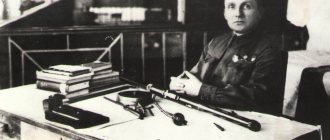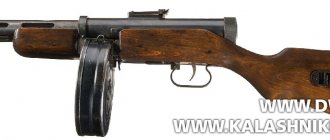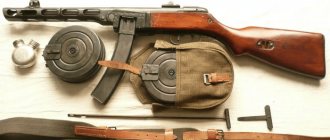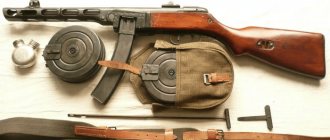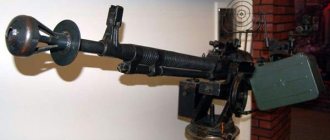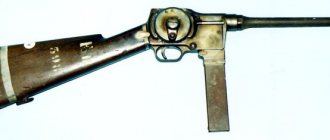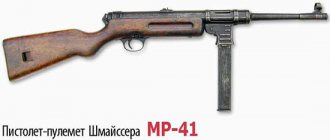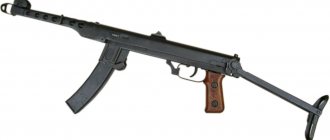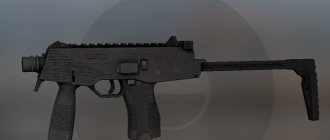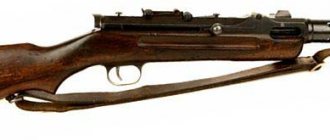Shpagin submachine gun (PPSh-41) - a symbol of victory in the Great Patriotic War Rarely a poster or film about the war is complete without an image of the Shpagin automatic submachine gun (PPSh-41). Along with the T-34 tank, “Katyusha”, it is rightly called the symbol of the Great Victory.
The designer, Georgy Semyonovich Shpagin, faced a difficult task - to create a model similar to the Degtyarev assault rifle, but superior in characteristics, cheap, easy to produce even at non-core enterprises. He coped with the task - in the middle of 40, the machine gun appeared in units and formations of the Red Army and soon became the most popular type of weapon.
With it in his hands, the Soviet soldier defended Moscow and Odessa, fought on the Kursk Bulge, in Stalingrad. He traveled halfway around the world with it and celebrated the victory with a burst of fire into the Berlin sky in May 1945.
They found a replacement for it only in the 60s, replacing it with a Kalashnikov assault rifle. For a long time, they were armed with rear and auxiliary units, soldiers of the internal and railway troops. Large supplies went to the countries of the commonwealth: they armed the armies of the Warsaw Pact countries.
Today, with some modifications, the PPSh is still in use, but for purely civilians: hunters use it as a carbine for amateur shooting.
History of the design and development of PPSh
The need for submachine guns arose during the First World War. For successful offensive actions, effective weapons were needed. The creation of German automatic weapons should begin with the modernization and redesign of Luger and Mauser pistols. But the attempts were unsuccessful: the pistols were light in weight, and strong recoil did not allow for targeted shooting. One of the successful samples was the MP-18, developed by designer Hugo Schmeisser. The machine had a well-thought-out design, and many products around the world were developed based on its mechanism. Its effectiveness was so high that after signing the surrender, the victorious countries banned Germany from producing automatic weapons.
The creator of the famous PPSh assault rifle Georgy Semenovich Shpagin
At this time, the Soviet Union did not attach importance to the development of a submachine gun. There were unsuccessful attempts by the Tokarev Design Bureau to create an assault rifle with a Nagant cartridge, but it did not have the necessary power and was not structurally intended for automatic firing.
Finnish (winter) campaign. Understanding the importance of the work had to be paid in great blood. In contrast to the Suomi submachine gun, against which our military had practically no chance, the PPD-34 (Vasily Alekseevich Degtyarev’s submachine gun) was quickly modified and adopted into service. Outwardly, it resembled the Finnish one, although the mechanisms had significant differences. After modernization, it suited the military, but production was expensive, rather complex, and not suitable for mass production.
That is why a competition is being announced to create a new submachine gun, which in technical and shooting characteristics will not be inferior to the PPD, but cheaper, simpler in design, with the possibility of production at non-core enterprises.
Two designers presented their models - Georgy Semenovich Shpagin and Boris Gavriilovich Shpitalny. Since the same type of ammunition was used, their combat characteristics were approximately the same. Based on the results of shooting and field tests, the commission recognized Shpagin’s product as more reliable, trouble-free, and cheaper to produce. It was the right choice. The experience of the war years showed that the assembly of a machine gun, which, in addition to the mechanism, barrel and butt, was one solid sheet of metal, could be entrusted to a schoolchild. No high qualifications were required.
The PPSh-41 (Shpagin submachine gun model 1941) went into serial production in December 1940. On the fields of the Great Patriotic War, he became the main “actor”, “director” of military operations.
Creation Story
Submachine guns (we sometimes call them machine guns) appeared during the First World War, together with tanks, chemical weapons and machine guns. The last type of weapon, although it was known earlier, its finest hour was specifically the 1st global war. And if the machine gun was an impeccable defensive weapon at that time, the submachine gun was developed as a new offensive type of weapon.
The first drawings of a rapid-fire gun chambered for a pistol cartridge of a huge caliber appeared back in 1915. According to the developers' plan, this weapon was supposed to assist the advancing troops, because it was distinguished by its high rate of fire and maneuverability. Machine guns of that time had impressive dimensions; moving them along with the advancing troops was problematic.
Drawings of such a weapon were developed in almost all countries: Italy, Germany, the USA and Russia, but submachine guns were not able to have a particular impact on the finale of the conflict. But the period of time between the two global wars became the true era of the heyday of this small arms.
There were two concepts for using machine guns. According to the first, the submachine gun was a smaller and lighter analogue of an ordinary machine gun. It was often equipped with a bipod, a long replaceable barrel, and sights that allowed it to shoot at several hundred meters. A common example of such use was the Finnish Suomi assault rifle, which was well used by the Finnish army in the war with the USSR.
Another concept was to arm auxiliary units, fighters of the 2nd lane, and officers with submachine guns, in other words, machine guns were considered as an auxiliary weapon, a possible replacement for a pistol.
custom_block(1, 8166095, 3671);
In the USSR they adhered to the second point of view. The development of submachine guns began in the mid-20s. The 7.63×25 Mauser, with a bottle-shaped cartridge case, was chosen as the cartridge for the future machine gun. In 1929, a competition was announced to develop a new weapon. The country's best designers began to prepare drawings, among them was Vasily Alekseevich Degtyarev, whose submachine gun was adopted for service in 1934.
They began to produce it in relatively small quantities; the Russian military administration at that time considered machine guns only an auxiliary, police weapon.
This worldview began to change after the unsuccessful Finnish campaign, in which Finnish troops successfully used submachine guns. The rugged terrain was perfect for introducing automatic weapons. The Finnish Suomi submachine gun made a huge impression on Russian military leaders.
The Russian military administration took into account the experience of the Finnish war and decided to create a new submachine gun chambered for the same Mauser cartridge. The development was entrusted to several designers, among them was Shpagin. They were entrusted with creating a weapon no worse than the Degtyarev assault rifle, but at the same time significantly simpler and cheaper. After reviewing the drawings and conducting tests, the Shpagin assault rifle was found to meet all requirements.
From the first days of the war, it turned out that this weapon was very excellent, especially with a high density of artillery and mortar fire, in close combat conditions. But there were very few of these weapons in the warehouses of the People's Commissariat of Defense. The large-scale creation of the PPSh-41 was launched at several factories; by the end of 1941 alone, more than 90 thousand PPSh-41 units were produced, and during the war years, 6 million machine guns were produced.
The simplicity of the design and the wealth of stamped parts made the PPSh-41 very cheap and easy to manufacture. This weapon was very effective, had the highest rate of fire, good accuracy of fire and the highest reliability.
custom_block(5, 4217374, 3671);
The 7.62 mm cartridge had the highest speed and excellent penetration capabilities. In addition, the PPSh-41 had amazing survivability: more than 30 thousand bullets could be fired from this gun.
But the most important thing in wartime criteria was the simplicity of this weapon. PPSh-41 consisted of 87 parts; it took only 5.6 machine hours to create 1 product. The PPSh-41 only achieved precise processing on the barrel and partly on the bolt; all other elements were produced using stamping.
Description of the design and operating principle of the PPSh
Shpagin submachine gun.
Poster from the times of the Great Patriotic War The design, as noted above, is quite simple: two boxes - a receiver and a bolt, and a trigger mechanism. All this is located on a wooden stock that goes into the butt. It had 87 parts and only two threaded connections.
The automatic action is driven by the movement of a free-moving massive shutter, powered by recoil energy. The mainspring, restrained by the trigger in the neutral position, when pressed, is cocked and activated. It straightens, pushes the bolt forward, the primer is pierced - a shot is fired. Under the influence of recoil, the bolt moves in the direction opposite to the shot, the cartridge case is ejected, and a new cartridge takes its place. If the trigger is still pressed, the action is repeated. With the help of a shock absorber located behind the recoil spring, vibration when the bolt rolls back is reduced. The cartridge is fed from a drum or sector type magazine.
Barrel casing functions:
- Holding onto the forend, the fighter did not get burned on the barrel;
- Cooling occurs due to the cutouts;
- Serves as a muzzle brake, which reduces recoil;
- The oblique cut of the muzzle when shooting reduces its upward jerks.
The chrome-plated barrel simplifies cleaning and reduces corrosion.
Description
The Shpagin submachine gun is chambered for a 7.62 mm caliber cartridge. The gun's automation operates according to a scheme with the introduction of free-breech recoil. At the moment of firing, the bolt is in the last rear position, then it moves forward, sending the cartridge into the chamber, piercing the primer.
custom_block(1, 61932590, 3671);
The impact mechanism allows you to fire both single shots and bursts. The fuse is on the bolt.
The receiver is connected to the barrel shroud, which has a very interesting design. There are corresponding rectangular holes made in it, which serve to cool the barrel; in addition, the front oblique cut of the casing is covered with a diaphragm, which makes it a muzzle brake-compensator. It prevents the barrel from lifting up when firing and reduces recoil.
The receiver contains a powerful bolt and a recoil spring.
At first, the sights consisted of a sector sight, then it was changed to a reversible sight with 2 values: 100 and 200 meters.
For quite a long time, the PPSh-41 was equipped with a drum magazine with a capacity of 71 rounds. It is one hundred percent similar to the magazine of the PPD-34 assault rifle. But this store has proven itself very disgracefully. It was heavy, difficult to manufacture, but most importantly, unreliable. Each drum magazine was fitted only to a specific machine gun; it often jammed, and if water got into it, it became frozen solid in the cold. Well, equipping it was quite difficult, especially in combat conditions. Later, it was decided to change it to a carob magazine with a capacity of 35 rounds.
The machine's stock was made of wood, usually birch was used.
Submachine guns chambered for a different cartridge, with a 9 mm caliber (9x19 Parabellum), were also developed. To do this, in the PPSh-41 it was enough to change the barrel and magazine receiver.
Ammunition for a submachine gun
Ammunition for the Shpagin submachine gun
For a long time, the machine gun was equipped with a drum-type magazine for 71 rounds of 7.62x25 caliber. However, the magazine is the weakest link of the PPSh - it is difficult to manufacture, heavy, and has low reliability. The cartridges warped, jammed, and in winter when moisture got in, it simply froze. It was difficult to reload in combat. It was decided to replace it with a horn with 35 cartridges. But many left the familiar, somewhat modified drum: a reserve, especially in battle, is never superfluous.
Technical characteristics (performance characteristics PPSh)
| Adopted | 1940 |
| Years of production | 1940 – 1947 |
| Total issued | about 6 million |
| Weight | |
| without cartridges, kg | 3.6 |
| with equipped drum, kg | 5.3 |
| with equipped sector magazine, kg | 4.15 |
| Dimensions | |
| length, mm | 843 |
| barrel length, mm | 269 |
| Cartridge | 7.62x25 mm TT |
| Rate of fire, rounds/min. | 1 000 |
| Magazine volume | sector magazine for 35 rounds, drum magazine for 71 rounds |
| Aim | non-adjustable, open, 100 m, with folding stand 200 m |
| Work principles | blowback |
| Muzzle energy, J | 508-576 |
| Initial bullet speed, m/s | 500 |
| Sighting range, m | 200-300 |
| Maximum range, m | 400-600 |
History of creation
Let's start with the fact that the Shpagin submachine gun appeared in the army just before the war. Perhaps this is why this model became the most popular automatic weapon of the Second World War. Let us add that the PPSh was distinguished by its ease of manufacture, so it could be produced by non-core enterprises. For example, all turning work necessary to create one machine gun was completed in 7 hours. At the same time, the specialist might not be of the highest qualifications. Captured PPSh were used by Wehrmacht units, although they had to be converted to use Parabellum ammunition.
Shpagin, Georgy Semenovich
Interesting! The Shpagin assault rifle was mass-produced until the mid-60s, but even after that it continued to be in service in rear units and military formations.
However, this will happen a little later. In the meantime, let's go back to 1940. It was at this time that the decision was made to arm the Red Army soldiers with more technologically advanced and modern machine guns. The People's Commissariat of Armaments of the USSR came to this conclusion, based on the experience of the Finnish Military Company. The task was simple: to create a weapon no worse than the Degtyarev submachine gun, while being more technologically advanced, simpler and cheaper in mass production.
In November 1940, prototypes of small arms developed by the Shpagin and Shpitalny design bureaus were presented to the commission. During the tests, submachine guns were tested for rate of fire and accuracy of fire. The weight and dimensions of each product were taken into account. PPD-40 was used as a standard, with which the results of the samples submitted for testing were compared.
Based on the test results, the People's Commissariat commission recognized the model designed by Shpagin as more promising. The following factors influenced the decision. PPSh was recognized as more reliable in operation and easier to manufacture. Shpitalny's assault rifle was slightly more accurate, but weighed about 1.5 kilograms more.
Just a month after the tests, the PPSh was adopted by the Soviet army and put into mass production.
Designer G.S. Shpagin (left) tests his machine gun. 1943
Advantages and disadvantages
Advantages:
- Simplicity of design, low cost. This is what made it possible to put the machine gun into production in the shortest possible time and arm the soldiers of the Red Army;
- High combat effectiveness. Extremely high rate of fire, a record among submachine guns of that period. For close combat - “lethal weapon”. What the bullet could not destroy could be finished off with a heavy birch butt;
- High muzzle energy, lethal and penetrating effect of the bullet. Even today, a PPSh bullet is capable of penetrating class B1 body armor.
- The effective firing range of the PPSh is almost 1.5 times higher than the German MP-38/40.
Red Army soldier in Berlin
For the Red Army, this was a very successful model of automatic small arms. Its effectiveness was so high that the Germans willingly exchanged their MP-40 for a Soviet machine gun.
But there were some shortcomings, most of which were eliminated during operation:
- The high rate of fire for the young warrior, who released the entire magazine in a matter of minutes, could result in death. The fighters called the PPSh a “cartridge eater”;
- Inconvenient and heavy design. With a loaded magazine, the weight was 5.3 kg, plus spare ammunition. This was partially solved by using a carob magazine, which was lighter but of smaller volume;
- Each sample is individual. With the help of cold stamping you can maintain a high production rate, but the disadvantage is the uniqueness of each magazine - they are not interchangeable. Since three magazines are attached to the machine gun, this is a serious problem;
- Due to the low reliability of the fuse, spontaneous discharge is possible upon impact or fall.
Despite its shortcomings, the machine gun was a formidable weapon at that time.
Legends associated with PPSh
An unlimited number of different legends have formed around this weapon. Let's try to dispel the most common of them:
- PPSh-41 was a complete copy of the Finnish Suomi assault rifle. It is not true. On the outside they are really similar, but the internal design is quite different. It can be added that many submachine guns of that time are very similar to each other.
- The Russian troops did not have many machine guns, and the Nazis were all armed with MP-38/40. This is also not true. The main weapon of Hitler's troops was the Mauser K98k carbine. According to the staffing schedule, one submachine gun was assigned to a platoon, then they began to be issued to squad commanders (5 people per platoon). The Germans equipped paratroopers, tank crews and auxiliary units en masse with machine guns.
- PPSh-41 is the best submachine gun of the 2nd World War. This statement also does not correspond to reality. The PPS-43 (Sudaev submachine gun) was recognized as the best machine gun of that war.
Modifications of PPSh
Soviet Union
Mod.41 g. Disc magazine with a capacity of 71 rounds, sector sight, designed for a firing range of 500 m, with rifling of 50 m. Production began before it was put into service.
Mod.42 g. The drum was replaced with a sector one, a reliable latch was installed, eliminating the possibility of loss, the sight was a rotating rear sight with slots for shooting at 100 and 200 m, a chrome-plated barrel was installed.
During operation, the design changed, the production technology was simplified.
Over the years, in addition to the official ones, handicraft versions of the machine gun were made. Thus, in partisan detachments, models were made manually, practically without drawings of PPSh, which immediately found use in battles with the Nazi invaders, thereby testing their performance. But can they be considered modifications?
Foreign production
The Germans made up for the lack of effective small arms by converting the PPSh to a 9 mm cartridge, using a magazine from the MP 38/40. The model was named MP.41(r). More than ten thousand pieces were converted.
German model MP.41(r)
The arms factory in Tehran produced samples called “Model 22”. Several tens of thousands were produced.
Iranian "model 22"
Socialist Republic of Romania – PM PP S Md. (1952)
Hungarian People's Republic - "7.62mm Geppisztoly 48.Minta" (1949-1955)
PRC - "Type 50". To adapt, minor changes were made to the design and production technology
Yugoslavia - M49 submachine gun (M49/56 and M49/57), have some design differences from the PPSh (1949-1992)
Vietnam - modification of PPSh - K-50 (1964-1973)
Legendary PPSh
The PPSh-41 submachine gun is not just a well-known (at least externally) machine gun from the Second World War, which habitually complements the common images of a Belarusian partisan or a Red Army soldier. Let's put it another way - in order for all this to be so, it was necessary to solve a number of very serious problems in due time.
Each type of weapon also shapes the tactics of its use. At the time when the submachine gun was created in the USSR, the main and only weapon of the infantryman was a repeating rifle. From the time of the invention of gunpowder until that time, despite the spread of machine guns and the use of automatic rifles (which were tactically a lightweight replacement for the same machine guns), despite the perfection of repeating rifles, weapons that fired only single fire continued to remain in the hands of the soldier. This is hundreds of years of single-shot shotguns and tens of years of repeating rifles. In this system, the idea of the structure and tactics of using a machine gun in infantry is to some extent comparable with the idea of the fourth dimension.
Submachine guns appeared at the end of the First World War. Due to the lack of ideas about the most advantageous tactics for using a new type of weapon, the shape of submachine guns gravitated towards repeating rifles - the same awkward butt and wooden stock, and the weight and dimensions, especially when using large-capacity drum magazines, did not imply the maneuverability which submachine guns acquired later.
The idea of a submachine gun is to use a pistol cartridge for automatic shooting in an individual weapon. The low power of the cartridge, in comparison with a rifle cartridge, makes it possible to implement the simplest principle of automatic operation - the recoil of a massive free bolt. This opens up the opportunity to make weapons extremely simple, both structurally and technologically.
By the time the PPSh was created, a number of fairly advanced and reliable models of submachine guns already existed and were widespread. These are the Finnish Suomi submachine gun of the A.I. Lahti system, and the Austrian Steyer-Soloturn C I-100 designed by L. Stange, and the German Bergman MP-18/I and MP-28/II designed by H. Schmeisser, the American pistol- Thompson machine gun and our Soviet PPD-40 submachine gun (and its early modifications), which was produced in small quantities.
Looking at the foreign policy of the USSR and the international situation, it is clear that the need to have a modern model of a submachine gun in service, albeit with some delay, has become ripe in the USSR.
But our requirements for weapons have always differed (and will differ) from the requirements for weapons in the armies of other countries. This is maximum simplicity and manufacturability, high reliability and failure-free operation in the most difficult conditions, and all this while maintaining the highest combat qualities.
The PPSh submachine gun was developed by designer G.S. Shpagin in 1940 and was tested along with other types of submachine guns. Based on the test results, the PPSh submachine gun was recognized as the most satisfying of the requirements and was recommended for adoption. Under the name “7.62-mm submachine gun G.S. Shpagin arr. 1941" it was put into service at the end of December 1940. As D.N. Bolotin points out (“History of Soviet Small Arms”), the survivability of the sample designed by Shpagin was tested with 30,000 shots, after which the PP showed satisfactory accuracy of fire and good condition of the parts. The reliability of the automation was tested by shooting at elevation and declination angles of 85 degrees, with the mechanism artificially dusty, in the complete absence of lubrication (all parts were washed with kerosene and wiped dry with a rag), and by shooting 5,000 rounds of ammunition without cleaning the weapon. All this allows us to judge the exceptional reliability and reliability of the weapon along with high combat qualities.
At the time of the creation of the PPSh submachine gun, the methods and technologies of stamping and cold metal working were not yet widespread. However, a significant percentage of PPSh parts, including the main ones, were designed for production by cold stamping, and some parts - by hot stamping. Thus, Shpagin successfully implemented the innovative idea of creating a stamp-welding machine. The PPSh-41 submachine gun consisted of 87 factory parts, while the machine gun had only two threaded places, the threads were simple fasteners. The processing of parts required a total output of 5.6 machine hours. (Data are given from the table of technological assessment of submachine guns, placed in the book by D.N. Bolotin “History of Soviet Small Arms”).
In the design of the PPSh submachine gun there were no scarce materials, there were not a large number of parts requiring complex processing, and seamless pipes were not used. Its production could be carried out not only at military factories, but also at any enterprises with simple press and stamping equipment. This was the result of the simple operating principle that makes it possible to implement a submachine gun, on the one hand, and a rational design solution, on the other.
Structurally, the PPSh submachine gun consists of a receiver and bolt boxes connected by a hinge, and in the assembled machine gun locked by a latch located in the rear part of the receiver, a trigger box located in the stock, under the bolt box, and a wooden stock with a butt.
A barrel is placed in the receiver, the muzzle of which goes into the hole in the barrel guide in the front part of the receiver, and the breech part goes into the hole in the liner, where it is pinned by the hinge axis. The receiver is also a barrel casing, and is equipped with rectangular cutouts for air circulation that cools the barrel during firing. In the front part, the oblique cut of the casing is covered with a diaphragm with a hole for the passage of a bullet. This arrangement of the front part of the casing serves as a muzzle brake-compensator. Powder gases, acting on the inclined surface of the diaphragm and flowing up and to the sides through the casing cutouts, reduce recoil and reduce upward movement of the barrel.
Shutter box PPSh-41
The barrel of the PPSh submachine gun is removable and can be separated during complete disassembly and replaced with another. The bolt box contains a massive bolt, pressed by a recoil spring. In the rear part of the bolt box there is a fiber shock absorber that softens the shock of the bolt in the rearmost position when firing. A simple safety device is mounted on the bolt handle, which is a slider that moves along the handle, which can fit into the front or rear cutouts of the receiver and, accordingly, lock the bolt in the front (stowed) or rear (cocked) position.
The trigger box houses the trigger mechanism and the release mechanism. The button for switching types of fire is located in front of the trigger and can occupy the extreme forward position, corresponding to single shooting, and the extreme rear position, corresponding to automatic shooting. When moved, the button moves the disconnector lever away from the trigger pull or interacts with it. When the trigger is pressed, the shutter, released from the combat cock, moving forward, deflects the disconnector lever down, and the latter, if engaged with the trigger pull, presses it and thereby releases the trigger lever, which returns to its original position.
Initially, a drum magazine with a capacity of 71 rounds was adopted for the PPSh submachine gun. The magazine consists of a magazine box with a lid, a drum with a spring and feeder, and a rotating disk with a spiral ridge - a volute. There is an eyelet on the side of the magazine body that allows you to carry magazines on your belt in the absence of bags. The cartridges in the magazine are placed in two streams, along the outer and inner sides of the spiral ridge of the snail. When feeding cartridges from an external stream, the snail rotates along with the cartridges under the action of a spring-loaded feeder. In this case, the cartridges are removed by the bend of the box located at the receiver and taken out into the receiver, onto the dispensing line. After the cartridges of the external stream are used up, the rotation of the snail is stopped by a stopper, while the output of the internal stream is aligned with the receiver window, and the cartridges are squeezed out of the internal stream by the feeder, which, without stopping its movement, now begins to move relative to the stationary snail.
PPSh-41 modification with night vision device
To fill the drum magazine with cartridges, it was necessary to remove the magazine cover, turn the drum with the feeder two turns and fill the snail with cartridges - 32 cartridges in the internal stream and 39 in the external one. Then release the locked drum and close the magazine with the lid. There was also a simple device to speed up the loading of a store. But all the same, as can be seen from the description, equipping the store, while not difficult in itself, was a long and difficult task in comparison with equipping the now common box stores. In addition, with a drum magazine, the weapon was quite heavy and bulky. Therefore, during the war, a much simpler and more compact box-shaped sector magazine with a capacity of 35 rounds was adopted for the PPSh submachine gun, along with the drum one.
Initially, the PPSh submachine gun was equipped with a sector sight designed for shooting at a distance of up to 500 m, cut at every 50 meters. During the war, the sector sight was replaced by a simpler rear sight with two slits for shooting at 100 and 200 m. Combat experience has shown that such a distance is quite sufficient for a submachine gun and such a sight, simpler in design and technology, does not reduce combat qualities of the weapon.
PPSh-41, modification with a curved barrel and a box magazine for 35 rounds
In general, during the war, in conditions of mass production, with the production of tens of thousands of PPSh monthly, a number of changes were consistently made to the design of weapons aimed at simplifying the production technology and making the design of some components and parts more rational. In addition to changing the sight, the hinge design was also improved, where the cotter pin was replaced with a split spring tube, which simplified mounting and replacement of the barrel. The magazine latch has been changed, reducing the likelihood of accidentally pressing it and losing the magazine.
The PPSh submachine gun proved itself so well on the battlefield that the Germans, who generally widely practiced the use of captured weapons, from rifles to howitzers, willingly used the Soviet machine gun, and sometimes German soldiers preferred the PPSh to the German MP-40. The PPSh-41 submachine gun, used without design changes, had the designation MP717(r) (“r” in parentheses stands for “russ” - “Russian”, and was used in relation to all captured models of Soviet weapons).
71-round drum magazine
Drum magazine for 71 rounds disassembled
The PPSh-41 submachine gun, converted to fire 9x19 Parabellum cartridges using standard MP magazines, was designated MP41(r). The modification of the PPSh, due to the fact that the 9x19 Parabellum and 7.62 x 25 TT (7.63 x 25 Mauser) cartridges are created on the basis of one cartridge case and the diameters of the cartridge case bases are completely identical, consisted only of replacing the 7.62 mm barrel to 9 mm and installing an adapter for German magazines in the receiving window. In this case, both the adapter and the barrel could be removed and the machine gun could be turned back into a 7.62 mm model.
The PPSh-41 submachine gun, having become the second consumer of pistol cartridges after the TT pistol, required not only an immeasurably larger production of these cartridges, but also the creation of cartridges with special types of bullets that are not required for a pistol, but are necessary for a submachine gun, and not police, but military. Along with the previously developed cartridge for the TT pistol with an ordinary bullet with a lead core (P), cartridges with armor-piercing incendiary (P-41) and tracer (PT) bullets were developed and put into service. In addition, at the end of the war, a cartridge with a bullet with a stamped steel core (Pst) was developed and put into production. The use of a steel core, along with saving lead, increased the penetrating effect of the bullet.
Due to the acute shortage of non-ferrous metals and bimetal (steel clad with tombak) and the growing needs of the active army for cartridges, during the war the production of cartridges with a bimetallic, and then completely steel, sleeve without any additional coating was launched. Bullets were produced mainly with a bimetallic jacket, but also with steel, without coating. The brass sleeve is designated “gl”, the bimetallic sleeve is designated “gzh”, and the steel sleeve is designated “gs”. (Currently, in relation to automatic and rifle-machine-gun cartridges, the abbreviation “gs” denotes a varnished steel casing. This is a different type of casing.) Full designation of cartridges: “7.62Pgl”, “7.62Pgzh”, etc.
PPSh-41 with a drum magazine for 71 rounds
PPSh-41 with a box magazine for 35 rounds
Combat use in history
Although the PPSh was officially replaced by the Kalashnikov assault rifle in the Soviet Union in the 50s, it managed to take part in many wars of the 20th century:
- 50s – Korean War;
- 60s - opposition to the American landing in Cuba, the initial period of the Vietnam War, Angola, the conflict in Palestine;
- 80s - Afghanistan, arming militias, self-defense units.
All data is taken from open sources, so if you do not agree with the information given in the article, want to challenge or supplement it, then write about it in the comments. We are grateful.
